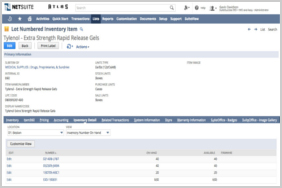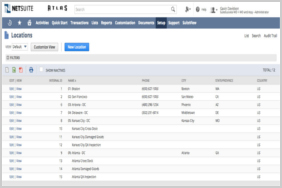Inventory Management
Manage inventory automatically. Reduce handling costs. Optimize cash flow.
There are many factors that go into Inventory Management, but the bottom line is that you need to make sure you have just enough inventory on hand in the right locations to meet demand—whether that demand is to meet your customers’ service level expectations or to supply a work order in your manufacturing facility.
NetSuite offers many native tools and features to help you make this happen including tracking inventory in multiple locations, safety stock, re-order points, cycle counts, demand planning and distribution requirements planning.
Features
Replenishment
Maintaining the right amount of inventory to support service level expectations is critical. NetSuite offers many tools to automate this process. Preferred stocking levels, lead times and re-order points can be automatically calculated in the system, with suggestions appearing instantly in the order items list. In our multi-location distribution requirements planning solution, more advanced parameters help you balance demand and supply across the entire organization.
Key Capabilities:
- Automatically calculate key settings
- View and manage inventory across your organization
- Multi-location planning

Cycle Counting
No matter how good your replenishment, tracking and management systems are, you need to do regular checks of actual inventory levels for key items. Keeping an accurate item count can help reduce required safety stock and lower your overhead costs. NetSuite’s Inventory Count feature improves inventory tracking and gives you more control over your assets. With this feature, you can categorize inventory based on volume of transactions and/or value. You can also enter regular periodic counts of on-hand item quantities to maintain inventory accuracy.
Key Capabilities:
- Increased accuracy of inventory levels
- Automatically prompts for items to be counted
- Categorize your items based on volumes / value etc.

Traceability
Companies require the ability to trace products from receipt back through their entire lifecycle. With NetSuite, you can define inventory and assembly items as being lot or serial tracked. The system will enforce the capture and identification of all related information on each transaction to provide full traceability. The inventory detail screen lets you view your inventory by lot or serial number and drill-down capabilities enable quick access to all related transactions.
Key Capabilities:
- Lot Tracking (multiple quantities)
- Serial Tracking (quantity of 1)
- Enforce full traceability

Warehousing
NetSuite offers unique capabilities when it comes to tracking inventory across multiple locations. The physical locations themselves can be hierarchical, allowing the creation of sub-locations. These locations can then be broken down into bins to provide a more finite level of tracking. Once the locations and bins are defined, any item can be stored in any location, which gives you a holistic view of inventory levels across all physical locations.
Key Capabilities:
- Multi-location tracking
- Hierarchical location definitions
- Bin tracking






























